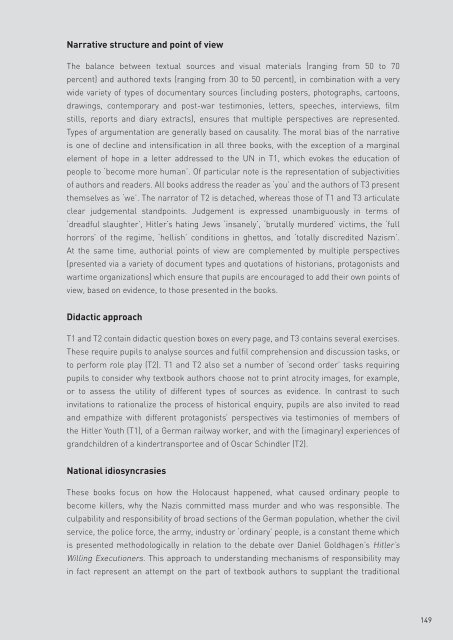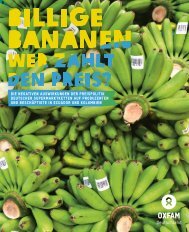228776e
228776e
228776e
Create successful ePaper yourself
Turn your PDF publications into a flip-book with our unique Google optimized e-Paper software.
Narrative structure and point of view<br />
The balance between textual sources and visual materials (ranging from 50 to 70<br />
percent) and authored texts (ranging from 30 to 50 percent), in combination with a very<br />
wide variety of types of documentary sources (including posters, photographs, cartoons,<br />
drawings, contemporary and post-war testimonies, letters, speeches, interviews, film<br />
stills, reports and diary extracts), ensures that multiple perspectives are represented.<br />
Types of argumentation are generally based on causality. The moral bias of the narrative<br />
is one of decline and intensification in all three books, with the exception of a marginal<br />
element of hope in a letter addressed to the UN in T1, which evokes the education of<br />
people to ‘become more human’. Of particular note is the representation of subjectivities<br />
of authors and readers. All books address the reader as ‘you’ and the authors of T3 present<br />
themselves as ‘we’. The narrator of T2 is detached, whereas those of T1 and T3 articulate<br />
clear judgemental standpoints. Judgement is expressed unambiguously in terms of<br />
‘dreadful slaughter’, Hitler’s hating Jews ‘insanely’, ‘brutally murdered’ victims, the ‘full<br />
horrors’ of the regime, ‘hellish’ conditions in ghettos, and ‘totally discredited Nazism’.<br />
At the same time, authorial points of view are complemented by multiple perspectives<br />
(presented via a variety of document types and quotations of historians, protagonists and<br />
wartime organizations) which ensure that pupils are encouraged to add their own points of<br />
view, based on evidence, to those presented in the books.<br />
Didactic approach<br />
T1 and T2 contain didactic question boxes on every page, and T3 contains several exercises.<br />
These require pupils to analyse sources and fulfil comprehension and discussion tasks, or<br />
to perform role play (T2). T1 and T2 also set a number of ‘second order’ tasks requiring<br />
pupils to consider why textbook authors choose not to print atrocity images, for example,<br />
or to assess the utility of different types of sources as evidence. In contrast to such<br />
invitations to rationalize the process of historical enquiry, pupils are also invited to read<br />
and empathize with different protagonists’ perspectives via testimonies of members of<br />
the Hitler Youth (T1), of a German railway worker, and with the (imaginary) experiences of<br />
grandchildren of a kindertransportee and of Oscar Schindler (T2).<br />
National idiosyncrasies<br />
These books focus on how the Holocaust happened, what caused ordinary people to<br />
become killers, why the Nazis committed mass murder and who was responsible. The<br />
culpability and responsibility of broad sections of the German population, whether the civil<br />
service, the police force, the army, industry or ‘ordinary’ people, is a constant theme which<br />
is presented methodologically in relation to the debate over Daniel Goldhagen’s Hitler’s<br />
Willing Executioners. This approach to understanding mechanisms of responsibility may<br />
in fact represent an attempt on the part of textbook authors to supplant the traditional<br />
149




